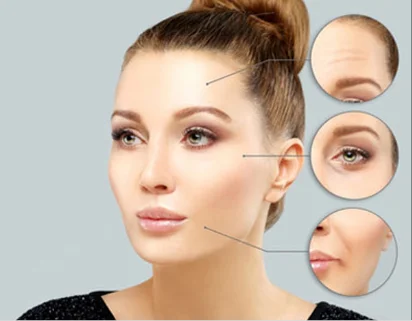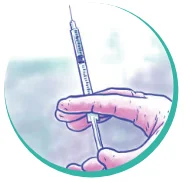Botox® Injection Sites
Neurotoxins | February 25, 2021

Botox® Injection Sites
Entry made by
Empire Medical Training
The FDA first approved Botox® for use in humans — specifically, for the anti-aging treatment of frown lines in the forehead — in 2002. Since then, the FDA and other national health authorities have cleared Botox and similar medications
derived from botulinum toxin A to treat dozens of cosmetic and therapeutic treatment procedures
The ever-expanding array of FDA-approved Botox
treatment procedures makes for an ever-expanding array of sites on the body where Botox can be injected safely and with optimal results. This necessitates a comprehensive examination of potential Botox injection sites in men
and women.
First, we’ll review what you can expect from this guide to Botox injection sites. We’ll then dive into specifics with a comprehensive overview of common treatment areas to inject botulinum toxin products
on the head, face, neck, and other regions of the body.
- The types of medical professionals most likely to administer Botox
- The prerequisites and training needed to safely administer Botox
- General guidelines for administering Botox in clinical settings
What to Expect From This Guide to Botox Injection Sites
- A detailed list of sites where Botox may be injected during an approved course of treatment for cosmetic or musculoskeletal issue
- Guidance around identifying optimal Botox injection locations
- Guidance around where not to inject Botox
- Guidance for safely and effectively injecting Botox at each site
- Monitoring Botox injection sites for possible side effects and complications
Where Botox Can Be Injected
Depending on the condition being treated, Botox injection sites may be found on the face, head, neck, underarms, abdomen, and feet. Common sites and corresponding conditions include:
- The forehead, for the treatment of forehead lines and one of several sites for the treatment of migraine
- The area above the bridge of the nose (between the eyes), for the treatment of “11” lines
- The corners of the eyes, for the treatment of fine lines and wrinkles (“crow’s feet”)
- The corners of the mouth, for the treatment of crooked or drooping smile
- The masseter (TMJ) muscles, for the treatment of involuntary jaw clenching (bruxism)
- The back of the head (occipital nerve area), for the treatment of migraine
- The underarms, for the treatment of hyperhidrosis (excessive sweating)
- The soles of the feet, also for the treatment of hyperhidrosis
- The bladder, for the treatment of urinary incontinence
Identifying Optimal Botox Injection Sites
evaluate individual patients to identify and mark the precise location for each injection ( Optimal Botox injection sites).
Depending on the condition being treated, this may involve asking the patient to make a series of controlled facial movements that indicate muscle location and massing. An ultrasound may be required to locate the optimal
injection site for urinary incontinence patients.
Where to Avoid Injecting Botox Botox should not be injected in muscle groups other than those indicated to treat the patient’s specific complaint.
When injected into indicated muscle groups, the position of the needle is important. Botox injections are generally intradermal or subcutaneous — that is, injected into the lower layer of skin, below the dermis, or
the fat layer below the skin. A too-shallow angle of entry may result in an injection that does not reach the target muscle, rendering the treatment ineffective. A too-deep angle may overshoot or bypass the target muscle,
greatly increasing the risk that the medication’s active ingredient spreads beyond the injection site and causes systemic side effects or complications.
Injectors must take care to avoid major blood vessels
that may spread the medication beyond the injection site and increase the risk of systemic complications. Injectors must also carefully review injection procedures for specific treatments, as the guidance above is highly
generalized and different treatments may require different injection angles and depths. Active measures may be required to ensure that the injection reaches the desired location beneath the skin. For example, when injecting
Botox into the lower eyelid, clinicians should use the non-dominant hand to pull back the skin of the lower eyelid and create a taut injection field.
Additionally, specific Botox injection sites present specific
considerations and risks. For example, injections around the eyes must take care to avoid the area proximate to the upper orbital bone. Here, a wayward injection can cause a new or worsened eyelid droop.
General
Guidance for Injecting Botox at Each Site Botox clinicians must do more than simply ensure the correct injection angle in the proper target muscle or muscle groups. Correct dosing, injection count, and injection frequency
are also crucial.
Dosing, in particular, varies by patient and condition. For example, Botox dosing for bruxism treatments involves several injections in three distinct muscles:
- 2 injections in the masseter muscle at 4 to 5 units each
- 4 injections in the temporalis muscle at 4 to 5 units each
- 2 injections in the lateral/medial pterygoid muscle at 4 units each

Treatment of smaller muscle groups or finer cosmetic issues may require fewer injections. For example, cosmetic treatment of depressed nasal tip typically involves just 2 injections into the nasal tip at 3 units each, for a total of 6 units of medication
delivered. By contrast, treatments of larger areas of the face or head typically involve 4 or more injections totaling upwards of 15 units. Clinicians must take care to avoid overdosing, which can increase the risk of complications,
while ensuring adequate dosing to produce the desired results.
To obtain specific guidance about safely and effectively injecting Botox to treat cosmetic or musculoskeletal conditions for
which the medication is indicated, it’s essential to get proper Botox course.
Possible Side Effects & Complications
Serious complications from Botox injection are quite rare, regardless of injection site or dosing. However, they do occur and both patients and providers must be aware of the risk. Further, providers must counsel patients on the possibility of such complications and clarify that they must seek treatment if symptoms occur. Complications that necessitate immediate medical evaluation include but aren’t limited to:
- Muscle weakness in specific muscle groups or throughout the body
- Urinary incontinence (loss of bladder control)
- Difficulty speaking or swallowing
- Vision problems

Less serious side effects of Botox may include:
- Crooked or lopsided smile (typically associated with injections around the mouth)
- Eyelid drooping (typically associated with injections around the eyes)
- Swelling or pain at the injection site
- Bruising at the injection site
- Headache (typically associated with injections to the forehead, neck, and shoulders)
- Flulike symptoms


